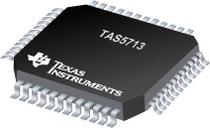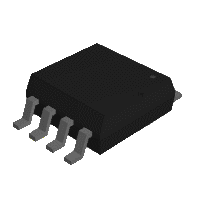●The TAS5713 is a 25-W, efficient, digital-audio power amplifier for driving stereo bridge-tied speakers. One serial data input allows processing of up to two discrete audio channels and seamless integration to most digital audio processors and MPEG decoders. The device accepts a wide range of input data and data rates. A fully programmable data path routes these channels to the internal speaker drivers.
●The TAS5713 is a slave-only device receiving all clocks from external sources. The TAS5713 operates with a PWM carrier between a 384-kHz switching rate and a 352-KHz switching rate, depending on the input sample rate. Oversampling combined with a fourth-order noise shaper provides a flat noise floor and excellent dynamic range from 20 Hz to 20 kHz..
● Audio Input/Output
● 25-W Into an 8- Load From a 20-V Supply
● Wide PVDD Range, From 8 V to 26 V
● Supports BTL Configuration With 4- Load
● Efficient Class-D Operation Eliminates Need for Heatsinks
● One Serial Audio Input (Two Audio Channels)
● I2C Address Selection Pin (Chip Select)
● Single Output Filter PBTL Support
● Supports 8-kHz to 48-kHz Sample Rate (LJ/RJ/I2S)
● Audio/PWM Processing
● Independent Channel Volume Controls With Gain of 24 dB to Mute
● Programmable Two-Band Dynamic-Range Control
● 22 Programmable Biquads for Speaker EQ and Other Audio-Processing Features
● Programmable Coefficients for DRC Filters
● DC Blocking Filters
● General Features
● I2C Serial Control Interface Operational Without MCLK
● Requires Only 3.3 V and PVDD
● No External Oscillator: Internal Oscillator for Automatic Rate Detection
● Surface-Mount, 48-Pin, 7-mm × 7-mm HTQFP Package
● Thermal and Short-Circuit Protection
● 106-dB SNR, A-Weighted
● AD and BD PWM-Mode Support
● Up to 90% Efficient
● Benefits
● EQ: Speaker Equalization Improves Audio Performance
● DRC: Dynamic Range Compression. Can Be Used As Power Limiter.
●Enables Speaker Protection, Easy Listening, Night-Mode Listening
● Autobank Switching: Preload Coefficients for Different Sample Rates.
●No Need to Write New Coefficients to the Part When Sample Rate Changes
● Autodetect: Automatically Detects Sample-Rate Changes.
●No Need for External Microprocessor Intervention

 Part 3D Model
Part 3D Model
